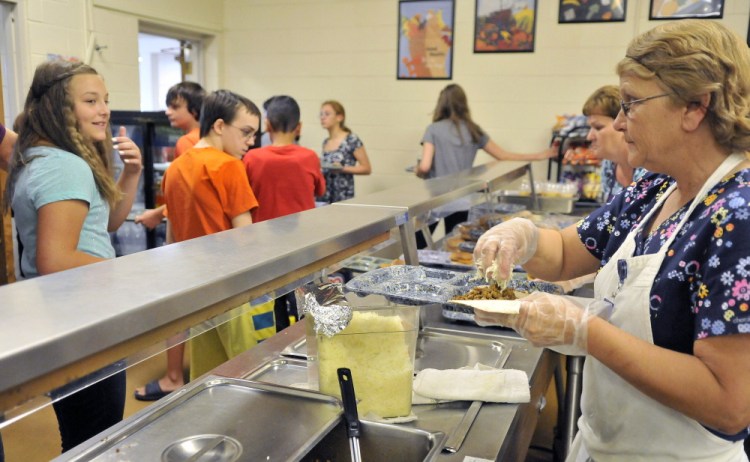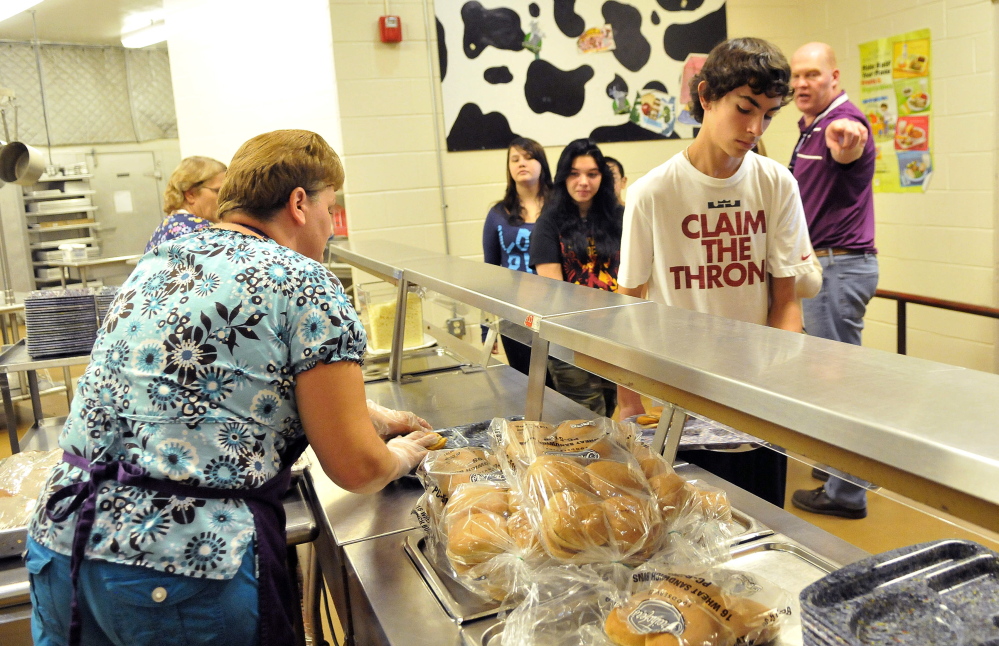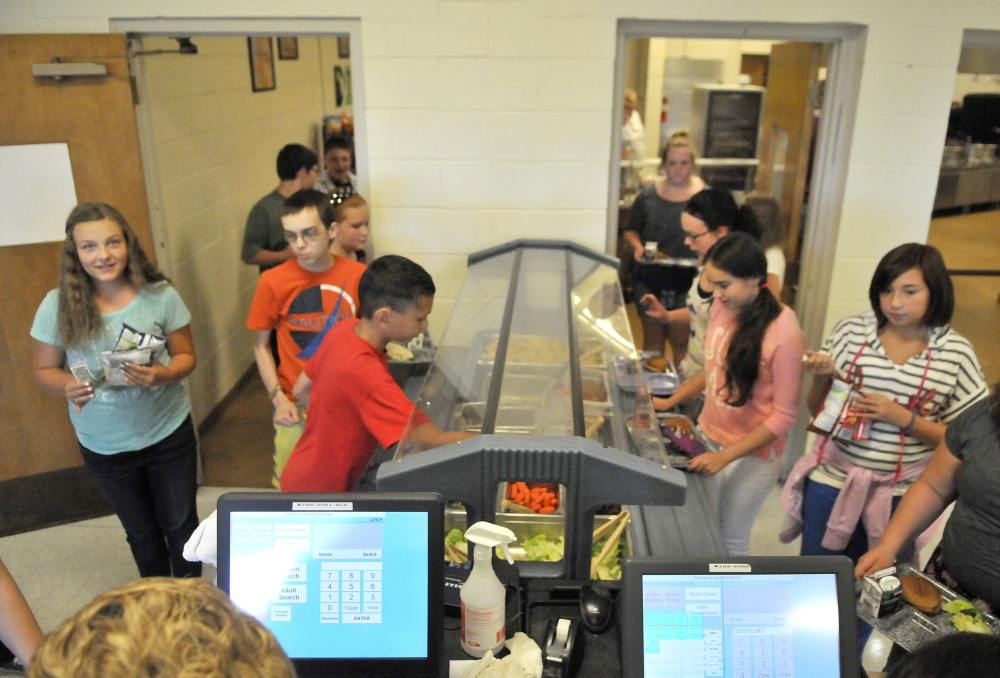A federal free breakfast and lunch program is so new and unfamiliar to Maine that some local school districts are hesitant to enact it, fearing the loss of money for other programs if they enroll.
The Community Eligibility Program is administered by the U.S. Department of Agriculture and is being offered under the Healthy, Hunger-Free Kids Act, enacted in 2010.
Eric Haley, superintendent of Alternative Organizational Structure 92, which includes Waterville, Winslow and Vassalboro schools, said Winslow and Vassalboro do not qualify for the program. Waterville does qualify, but Haley wants to ensure Waterville schools would not lose funding for other programs if they take part in the program.
“At this point, there are far too many questions and too many gambles,” Haley said.
Skowhegan-based School Administrative District 54 started the program when school opened this year, and Superintendent Brent Colbry says it is working well. He, too, initially was hesitant to enroll, but after researching the details he became confident the district wouldn’t lose money.
“I wrestled with it — I did,” Colbry said. “I was really concerned. The more I looked at the numbers and the more we talked, I thought the risk was relatively low, and it’s bearing out, I think.”
To enroll, districts must show that at least 40 percent of students met the requirements for free lunch the prior year. Districts also must agree to serve free breakfasts and lunches to all students, not collect applications from students’ households for free and reduced-price lunches and agree to cover with nonfederal funds any costs of providing free meals to all students above amounts paid in federal assistance.
Under the program’s regulations, a district can specify only individual schools or clusters of schools that qualify for the program if the percentage of students eligible for free lunch systemwide is too low for the district to qualify.
Haley said once a community enters the program, schools would no longer receive applications from households to determine whether students are eligible for free and reduced-price lunches. But those data, he said, are required for the district to receive funding for other programs, including receiving additional state education assistance money.
“So there is no way of knowing what your free and reduced count is; and by state statute, you get an extra 15 percent of reimbursement, which for us is about $1,000 per child,” he said. “If we have 1,800 students and we’re running 70 percent free and reduced(-price), 1,256 students times $1,000 each is $1 million.”
Paula Pooler, the district’s finance director, said AOS 92 officials would like to take part in the federal free breakfast and lunch program if possible, but they want to see how it works in other districts before doing it. She said she does not know whether AOS 92 would lose funding if it enrolled.
“There are just a lot of questions that are not answered at this time for us to go ahead and take that leap,” Pooler said.
The district’s food service program now is self-supporting because of federal reimbursements for free and reduced-price meals, paying customers and a federal government commodities program, according to Haley. The former food services director, Barbara Bonnell, now is food services quality control supervisor for the district; and she works with chefs in schools on professional development and focusing on making school meals from scratch rather than providing pre-made meals. Pooler is acting food services director in addition to being finance director.
The goal, according to Haley, is to save money and improve the quality of food being served.
Colbry, in Skowhegan, said that while SAD 54 did not send applications to students’ households for free and reduced-price lunches this year, it sent out similar, alternative forms asking for information that would collect the same data to be used for procuring funding other programs. A letter accompanied the applications saying the forms were not for free and reduced-price lunches, but for other programs.
The response from households was great, he said. Normally the forms trickle in, but people are returning them faster this year, and he thinks it is because of the new free meals program. Teachers are encouraging students to return the forms, and those who typically fail to bring forms back for fear of being stigmatized are doing so now.
Colbry said he also has noticed that students who typically did not eat meals at school, also for fear of being social outcasts, now are doing so.
The immediate goal, he said, is to ensure students are fed. They then learn better.
“It’s really exciting to go into the cafeteria and see all those kids eating, especially in the high school. It’s a socializing thing. This takes all that (stigma) away. The participation rate just blew me away.”
He said he thinks many school districts did not become aware of the program until summer and still are researching the details. He said he can understand their hesitation.
Colbry learned about the program in May and got a first memo about it in late July or early August He said he started asking questions about whether enrolling in the program would put funding for other programs at risk and is satisfied that the risk is low. He added that districts may drop the program at any time.
Meanwhile, Fairfield-based SAD 49 just missed the 40 percent eligibility, according to SAD 49 Superintendent Dean Baker. He said that in investigating the program, officials wanted to ensure they would not “lose in the process of gaining.”
Baker said he thinks school officials everywhere favor feeding as many students as possible. Providing food for students is the most cost-effective use of money that he can think of to help prepare students to learn, he said.
In a survey last year, SAD 49 found that more than one-third of students did not eat at least one meal a day with their families, according to Baker.
“That speaks to the style of modern society,” he said. “I’m not for socializing American life, but I think that it’s a reality of contemporary society — that families don’t get together in a predictable, consistent way that past generations have for things like eating together.”
Amy Calder — 861-9247
Twitter: @AmyCalder17
Send questions/comments to the editors.






Success. Please wait for the page to reload. If the page does not reload within 5 seconds, please refresh the page.
Enter your email and password to access comments.
Hi, to comment on stories you must . This profile is in addition to your subscription and website login.
Already have a commenting profile? .
Invalid username/password.
Please check your email to confirm and complete your registration.
Only subscribers are eligible to post comments. Please subscribe or login first for digital access. Here’s why.
Use the form below to reset your password. When you've submitted your account email, we will send an email with a reset code.